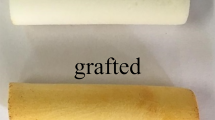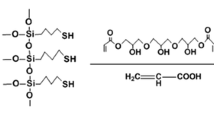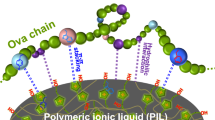Abstract
The authors have prepared a super-hydrophilic polymer consisting of a poly-polyhedral oligomeric silsesquioxane (POSS)-formaldehyde (PPF) composite. The polymerization process does not require a catalyst and results in a material with excellent hydrophilic properties and abundant functional groups. The PFF composite, even if not chemically modified, can selectively bind glycoproteins due to strong hydrophilic interactions. It is shown that glycoproteins can be selectively captured by the composite that has a binding capacity as large as 542 mg g−1 for the model protein ovalbumin. The PPF was applied to the selective capture and isolation of ovalbumin from complex biological samples.

Super-hydrophilic poly-polyhedral oligomeric silsesquioxane formaldehyde (PPF) is prepared via a catalyst-free polymerization route. PPF exhibits high capturing and adsorption selectivity towards glycoproteins due to its strong hydrophilic interaction with glycan groups. Favorable capturing capacity is also achieved.





Similar content being viewed by others
References
Service RF (2012) CELL BIOLOGY looking for a sugar rush. Science 338:321–323
Hakomori S (1996) Tumor malignancy defined by aberrant glycosylation and sphingo(glyco)lipid metabolism. Cancer Res 56:5309–5128
Kufe DW (2009) Mucins in cancer: function, prognosis and therapy. Nat Rev Cancer 9:874–885
Couldrey C, Green JE (2000) Metastases: the glycan connection. Breast Cancer Res 2:321–323
Drake PM, Cho W, Li BS, Prakobphol A, Johansen E, Anderson NL, Regnier FE, Gibson BW, Fisher SJ (2010) Sweetening the pot: adding glycosylation to the biomarker discovery equation. Clin Chem 56:223–236
Durand G, Seta N (2000) Protein glycosylation and diseases: blood and urinary oligosaccharides as markers for diagnosis and therapeutic monitoring. Clin Chem 46:795–805
Chen R, Jiang XN, Sun DG, Han GH, Wang FJ, Ye ML, Wang LM, Zou HF (2009) Glycoproteomics analysis of human liver tissue by combination of multiple enzyme digestion and hydrazide chemistry. J Proteome Res 8:651–661
Zhang H, Li XJ, Martin DB, Aebersold R (2003) Identification and quantification of N-linked glycoproteins using hydrazide chemistry, stable isotope labeling and mass spectrometry. Nat Biotechnol 21:660–666
Tang J, Liu YC, Qi DW, Yao GP, Deng CH, Zhang XM (2009) On-plate-selective enrichment of glycopeptides using boronic acid-modified gold nanoparticles for direct MALDI-QIT-TOF MS analysis. Proteomics 9:5046–5055
Zhang LJ, Xu YW, Yao HL, Xie LQ, Yao J, Lu HJ, Yang PY (2009) Boronic acid functionalized Core-satellite composite nanoparticles for advanced enrichment of glycopeptides and glycoproteins. Chem-Eur J 15:10158–10166
Dong LP, Feng S, Li SS, Song PP, Wang JD (2015) Preparation of Concanavalin A-chelating magnetic nanoparticles for selective enrichment of glycoproteins. Anal Chem 87:6849–6853
McDonald CA, Yang JY, Marathe V, Yen TY, Macher BA (2009) Combining results from lectin affinity chromatography and Glycocapture approaches substantially improves the coverage of the glycoproteome. Mol Cell Proteomics 8:287–301
Tian YA, Zhou Y, Elliott S, Aebersold R, Zhang H (2007) Solid-phase extraction of N-linked glycopeptides. Nat Protoc 2:334–339
Tan L, Chen KC, Huang C, Peng RF, Luo XY, Yang R, Cheng YF, Tang YW (2015) A fluorescent turn-on detection scheme for α-fetoprotein using quantum dots placed in a boronate-modified molecularly imprinted polymer with high affinity for glycoproteins. Microchim Acta 182:2615–2622
Li Y, Shah P, De Marzo AM, Van Eyk JE, Lo QQ, Chan DW, Zhang H (2015) Identification of glycoproteins containing specific glycans using a lectin-chemical method. Anal Chem 87:4683–4687
Hagglund P, Matthiesen R, Elortza F, Hojrup P, Roepstorff P, Jensen ON, Bunkenborg J (2007) An enzymatic deglycosylation scheme enabling identification of core fucosylated N-glycans and O-glycosylation site mapping of human plasma proteins. J Proteome Res 6:3021–3031
Bi CF, Zhao YR, Shen LJ, Zhang K, He XW, Chen LX, Zhang YK (2015) Click synthesis of hydrophilic maltose-functionalized iron oxide magnetic nanoparticles based on dopamine anchors for highly selective enrichment of glycopeptides. ACS Appl Mater Interfaces 7:24670–24678
Ma WF, Li LL, Zhang Y, An Q, You LJ, Li JM, Zhang YT, Xu S, Yu M, Guo J, Lu HJ, Wang CC (2012) Ligand-free strategy for ultrafast and highly selective enrichment of glycopeptides using Ag-coated magnetic nanoarchitectures. J Mater Chem 22:23981–23988
Zou X, Jie J, Yang B (2016) A facile and cheap synthesis of zwitterion coatings of the CS@PGMA@IDA nanomaterial for highly specific enrichment of glycopeptides. Chem Commun 52:3251–3253
Ma W, Xu L, Li Z, Sun Y, Bai Y, Liu H (2016) Post-synthetic modification of an amino-functionalized metal-organic framework for highly efficient enrichment of N-linked glycopeptides. Nanoscale 8:10908–10912
Roll MF, Kampf JW, Laine RM (2011) Crystalline hybrid Polyphenylene macromolecules from Octaalkynylsilsesquioxanes, crystal structures, and a potential route to 3-D Graphenes. Macromolecules 44:3425–3435
Lo MY, Zhen CG, Lauters M, Jabbour GE, Sellinger A (2007) Organic-inorganic hybrids based on pyrene functionalized octavinylsilsesquioxane cores for application in OLEDs. J Am Chem Soc 129:5808–5809
Liu H, Kondo SI, Takeda N, Unno M (2008) Synthesis of octacarboxy spherosilicate. J Am Chem Soc 130:10074–10075
Cai L, Chen J, Rondinone AJ, Wang S (2012) Injectable and biodegradable nanohybrid polymers with simultaneously enhanced stiffness and toughness for bone repair. Adv Funct Mater 22:3181–3190
Tanaka K, Inafuku K, Nakab K, Chujo Y (2008) Enhancement of entrapping ability of dendrimers by a cubic silsesquioxane core. Org Biomol Chem 6:3899–3901
Pawlak T, Kowalewska A, Zgardzinska B, Potrzebowski MJ (2015) Structure, dynamics, and host-guest interactions in POSS functionalized cross-linked Nanoporous hybrid organic-inorganic polymers. J Phys Chem C 119:26575–26587
Tanaka K, Inafuku K, Adachi S, Chujo Y (2009) Tuning of properties of POSS-condensed water-soluble network polymers by modulating the cross-linking ratio between POSS. Macromolecules 42:3489–3492
Sanil ES, Cho KH, Hong DY, Lee JS, Lee SK, Ryu SG, Lee HW, Chang JS, Hwang YK (2015) A polyhedral oligomeric silsesquioxane functionalized copper trimesate. Chem Commun 51:8418–8420
Feher FJ, Wyndham KD (1998) Amine and ester-substituted silsesquioxanes: synthesis, characterization and use as a core for starburst dendrimers. Chem Commun 3:323–324
Schwab MG, Fassbender B, Spiess HW, Thomas A, Feng XL, Mullen K (2009) Catalyst-free preparation of melamine-based microporous polymer networks through Schiff Base chemistry. J Am Chem Soc 131:7216–7217
Wang WJ, Hai X, Mao QX, Chen ML, Wang JH (2015) Polyhedral oligomeric silsesquioxane functionalized carbon dots for cell imaging. ACS Appl Mater Interfaces 7:16609–16616
de Groot J, Kosters HA, de Jongh HH (2007) Deglycosylation of ovalbumin prohibits formation of a heat-stable conformer. Biotechnol Bioeng 97:735–741
Parekh RB, Dwek RA, Sutton BJ, Fernandes DL, Leung A, Stanworth D, Rademacher TW, Mizuochi T, Taniguchi T, Matsuta K, Takeuchi F, Nagano Y, Miyamoto T, Kobata A (1985) Association of rheumatoid arthritis and primary osteoarthritis with changes in the glycosylation pattern of total serum IgG. Nature 316:452–457
Quast I, Lunemann JD (2014) Fc glycan-modulated immunoglobulin G effector functions. J Clin Immunol 34:S51–S55
Moore SA, Anderson BF, Groom CR, Haridas M, Baker EN (1997) Three-dimensional structure of diferric bovine lactoferrin at 2.8 angstrom resolution. J Mol Biol 274:222–236
Dorland L, Haverkamp J, Vliegenthart JFG, Spik G, Fournet B, Montreuil J (1979) Investigation by 360-MHz 'H-nuclear-magnetic-resonance spectroscopy and methylation analysis of the single glycan chain of chicken Ovotransferrin. J Biochem 100:569–574
Wang CQ, Eufemi M, Turano C, Giartosio A (1996) Influence of the carbohydrate moiety on the stability of glycoproteins. Biochemistry 35:7299–7307
Ding X, Cai J, Guo X (2015) Effect of surfactant structure on reverse micellar extraction of ovalbumin. Process Biochem 50:272–278
Zhang DD, Chen Q, Hu LL, Chen XW, Wang JH (2015) Preparation of a cobalt mono-substituted silicotungstic acid doped with aniline for the selective adsorption of ovalbumin. J Mater Chem B 3:4363–4369
Han L, Shu Y, Wang XF, Chen XW, Wang JH (2013) Encapsulation of silica nano-spheres with polymerized ionic liquid for selective isolation of acidic proteins. Anal Bioanal Chem 405:8799–8806
Zhang YT, Ma WF, Li D, Yu M, Guo J, Wang CC (2014) Benzoboroxole-functionalized magnetic Core/Shell microspheres for highly Specifi c enrichment of glycoproteins under physiological conditions. Small 7:1379–1386
Peng YH, Fu DM, Zhang FF, Yang BC, Yu L, Liang XM (2016) A highly selective hydrophilic sorbent for enrichment of N-linked glycopeptides. J Chromatogr A 1460:197–201
Acknowledgements
The authors appreciate financial support from the Natural Science Foundation of China (21275027, 21235001 and 21475017), Fundamental Research Funds for the Central Universities (N150502001, N140505003, N141008001).
Author information
Authors and Affiliations
Corresponding authors
Ethics declarations
The author(s) declare that they have no competing interests.
Electronic supplementary material
ESM 1
(DOC 1.23 mb)
Rights and permissions
About this article
Cite this article
Zhang, Y., Zhuang, Y., Shen, H. et al. A super hydrophilic silsesquioxane-based composite for highly selective adsorption of glycoproteins. Microchim Acta 184, 1037–1044 (2017). https://doi.org/10.1007/s00604-017-2100-z
Received:
Accepted:
Published:
Issue Date:
DOI: https://doi.org/10.1007/s00604-017-2100-z




